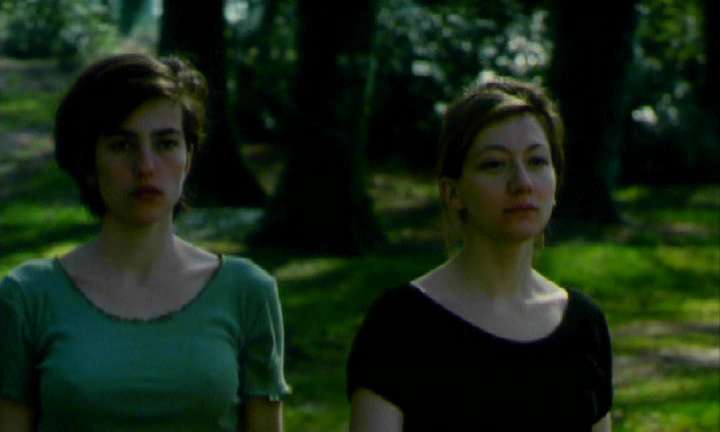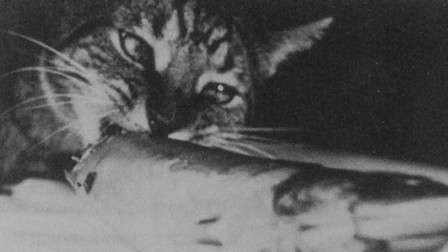His latest, a 5-minute experiment titled Odin’s Shield Maiden is quite beautiful if not all that thematically engaging. Essentially, it’s a series of black-and-white shots of several women mourning the drowning of a guy named Mundi near the shore. The photography is, needless to say, stunning, and Maddin’s lyrical rhythms are spot on. Still no Heart of the World (2001)–or even My Dad is 100 Years Old (2005)–but wonderful to watch, anyway.Read More »
Experimental
-
Guy Maddin – Odin’s Shield Maiden (2007)
2001-2010CanadaExperimentalGuy MaddinShort Film -
Elyseu Visconti – Os Monstros de Babaloo AKA The Monsters of Babaloo (1971)
1971-1980BrazilComedyElyseu ViscontiExperimental
If you like early John Waters pieces, you have to see this one. In fact, this movie was released a year earlier than Pink Flamingos. The director was also writer, art director and set decorator, in the traditon of underground cinema – the movie is considered part of the movement called Cinema Marginal and was banned by the military Brazilian authorities. –mandragoruRead More »
-
Gary Tarn – Black Sun (2005)
2001-2010DocumentaryExperimentalGary TarnUnited KingdomQuote:
Black Sun tells the story of Hugues de Montalembert, a French artist and filmmaker living in New York, who was blinded during a violent assault in 1978.
In telling the story of this unique man and his extraordinary reaction to a life-changing trauma, Tarn has created an expressionist film whose power lies in visualising a world from the perspective of the blind de Montalembert.
Part- survivor’s testimony, part- philosophical meditation on the nature of perception, BLACK SUN is a celebration of life that makes us see the world anew.Read More » -
Jürgen Reble – Passion (1990)
1981-1990ExperimentalGermanyJürgen Reble
Passion (1990) 
Quote:
PASSION is a film dairy in which daily events are related to archaic and evolutionary images. The chemical decomposition of the film emulsion blurs the borders between the microcosmic world of the embryo and macrocosmic elements. It leads to an alchemical quest for filmic expression based on the exploration of film’s physical material qualities. Sound segments and melody fragments combined with rhythmical pulsating, droning and hissing of natural events create a dramatic tension between image, sound and chemistry.
PASSION is a personal film-journey in which Reble accompanies his unborn child in a filmdiary, following the seasons until his birth. Reble’s unfamiliar chemistry generates slowly pulsating structures and colors. Micro- and macroscopic imagery build a near-abstract, hypnotic landscape – an intimate perception of creation.
(Re:Voir Video)Read More » -
Gerhard Benedikt Friedl – Hat Wolff von Amerongen Konkursdelikte begangen? aka Did Wolff von Amerongen Commit Bankruptcy Offenses? (2004)
2001-2010DocumentaryExperimentalGerhard Benedikt FriedlGermany
Quote:
The most remarkable discovery in recent German-language cinema: Gerhard Friedl’s first feature is a hypnotic visual puzzle at the interface of documentary, essay film and pulp fiction. On the soundtrack: an unflinchingly ‘objective’ account of the labyrinthine genealogies, criminal involvements and afflictions of Germany’s economic leaders in the 20th century. On the screen: pans and tracking shots through European financial centres, production sites and landscapes. The sheer depth and crispness of these images is a treat in itself; a transformation into cinégénie of what artists like Candida Höfer or Jeff Wall have done by means of still photography. At times, image and sound are aligned, at others they just miss each other. They invariably suggest correlations. Paranoia? Irony? Can the prosaic, criminal state of affairs of a modern economy be depicted at all? Pierre Rissient, the French film historian, puts the film where it belongs: “Fritz Lang would have loved it!”Read More » -
Werner Nekes & Dore O. – Beuys (1981)
1981-1990ExperimentalGermanyVideo ArtWerner NekesWerner Nekes and Dore O.Beuys 1981
11 min.
Format 16 mm colourThe term ‘visual arts’ that is prevailing in modernity is really a symptom for the reduction of perceptional categories within the human creativity as a whole. An anthropological conception of art – and I have proved for instance in sculptural theory that you hear a sculpture before you see it, that consequently the auditive element is not just an equal part, but a constituent of the perception of plastic art – confronts you with the task of exploring the conception of creativity in all directions, of spreading it out and substantiating it anthropologically. So for instance, the human creativity potential as a whole doesn’t only comprise the recognition criteria in thought, but it also comprises the sensational categories in the middle of the soul, that is, the moving element, and it positively comprises the will potential in human will. It is this interpretation of human creativity potential, beginning with the triple position, the connections of will, sense, and thought categories, which will get you to the more differentiated position of considering the perception, too, and thus the connection of human senses, discovering that for example seeing, the visual sense, the auditory sense, the static sense, the architectonic sense, the haptic sense, can be thought forward into the sense of feeling, the sense of will, the sense of thinking, and many other still to be developed senses.Read More »
-
Philippe Garrel – Le revelateur (1968)
1961-1970Amos Vogel: Film as a Subversive ArtDramaExperimentalFrancePhilippe GarrelThis film stands out as a fine example of the Zanzibar movement in France, and as a metaphor for the spirit of repression lived during that era. The film itself was recorded mostly near german concentration camps, and the crew had a lot of problems with the police, nonetheless they managed to shoot a really wonderful film, a continous portrait of escape through dark and gray landscapes much to the reminder of the wonderful text by Gorky, which starts: “Last night I was in the Kingdom of Shadows”.
–fitzRead More »
-
Pierre Coulibeuf – Le Démon du passage (1995)
1991-2000ArthouseExperimentalFrancePierre Coulibeuf
Le Démon du passage (The Demon of Passage)
35 mm – 14’ – 1995
“Fictional” reconstruction of the chain of mental images that make the visions of the photographer Jean-Luc Moulène appear.Read More » -
Joyce Wieland – Cat Food (1967)
1961-1970CanadaExperimentalJoyce Wieland
Cat Food
Canada / 13:30 min. / 1967
sound / color“In Catfood Wieland shows a cat devouring fish after fish for some ten minutes. There seems to be no repetition of shots, but the imagery is so consistent throughout–shot of the fish, the cat eating, his paw clawing, another fish, the cat eating, etc.–that it is just possible the shots are recurrent. There is no question that Wieland has a unique talent.”- P Adams Sitney, Film Culture
“A cat eats its methodical way through a polymorphous fish. The projector devours the ribbon of film at the same rate, methodically. The lay of Grimnir mentions a wild boar whose magical flesh was nightly devoured by the heroes of Valhalla, and miraculously regenerated next morning in the kitchen. The fish in Wieland’s film, and the miraculous flesh of the film itself, are reconstructed on the rewinds to be devoured again. Here is a dionysian metaphor, old as the West, of immense strength. Once we see that the fish is the protagonist of the action, this metaphor reverberates to incandescence in the mind.” – Hollis FramptonRead More »




